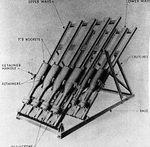Mousetrap Anti-Submarine Rocket Launcher
| Country of Origin | United States |
| Type | Launcher |
| Caliber | 182.880 mm |
| Length | 990.600 mm |
| Weight | 29.480 kg |
| Range | 182.800 m |
| Machinery | 2.25-inch MK 3 solid rocket motor |
| Explosive Charge | 30 pounds TNT or 33 pounds Torpex |
Contributor: David Stubblebine
ww2dbaseThe Mousetrap Anti-Submarine weapon was a forward firing array of small rockets designed to deliver a pattern of charges ahead of the firing vessel that covered an area roughly 40-yards across. Mousetrap was a direct follow-on design to the very successful British Hedgehog forward firing anti-submarine mortar. In fact, after some trial and error with the Mousetrap, it was found that the Hedgehog's 33-pound torpex warhead was more effective than earlier Mousetrap warheads and the Hedgehog warhead was used in the Mousetrap rockets. The principal difference between the two design concepts was that Hedgehog used a spigot-mortar launching system that created a 40-ton recoil force against the deck of the launching ship while the Mousetrap used a rocket and rail system that created almost no recoil. This also meant the launching systems mounted to the ships could be much lighter for the Mousetraps than for the Hedgehogs.In both cases, the weapons fired more conventional contact bombs rather than in depth charges. This had the advantages of simplified detonator mechanisms, faster sinking rates, instant feedback on whether an attack had successfully contacted a submarine, and did not interfere with sonar or ASDIC operations in those cases without contact. It also meant the Hedgehog and Mousetrap system could use smaller explosive charges since, by definition, they would be in direct contact with the submarine when they detonated rather than in proximity.
While the Hedgehog systems were generally considered more effective, the lighter launching systems and reduced recoil of the Mousetrap meant that they could be mounted on a larger number of patrol vessel types. Both the British Royal Navy and the United States Navy used both the Hedgehog and the Mousetrap systems during World War II but the Mousetrap was used more widely by the Americans, including in the Pacific Theater.
Even though Mousetrap was developed to sink German submarines, the system was responsible for sinking at least one Allied warship. On 3 Jan 1944, while anchored off Ambrose Light at the entrance to New York Harbor, the destroyer USS Turner suffered several magazine explosions attributed to faulty Mousetrap contact fuses. The Turner sank and 138 crewmen were lost.
Development of the Mousetrap led directly to the development of the substantially similar tank-mounted T37 "Whiz-Bang" demolition rocket for use against bunkers and other hardened land targets and also the "Woofus" rocket array launched from landing craft for shore bombardment.
Sources:
US Navy
Naval Weapons and Technology
Directory of U.S. Military Rockets and Missiles
Wikipedia
The Pacific War Online Encyclopedia ww2dbase
Last Major Revision: Jul 2019
Mousetrap Anti-Submarine Rocket Launcher Interactive Map
Photographs
 |  |
Mousetrap Anti-Submarine Rocket Timeline
| 3 Jan 1944 | While anchored off Ambrose Light about 10 miles east of Sandy Hook, New Jersey, United States at the entrance to New York Harbor, the destroyer USS Turner suffered several magazine explosions attributed to faulty Mousetrap contact fuses. The Turner sank at 0827 hours and 138 crewmen were lost. Nearby ships picked up the survivors, landing the injured to the hospital at Sandy Hook. A United States Coast Guard Sikorsky HNS-1 helicopter flown by Lieutenant Commander Frank A. Erickson delivered two cases of blood plasma from New York to Sandy Hook; it was the first time that a rotary wing aircraft had been used in a life-saving operation. |
Please consider supporting us on Patreon. Even $1 per month will go a long way! Thank you. Please help us spread the word: Stay updated with WW2DB: |
Change View
Desktop ViewSearch WW2DB
News
- » US Women's Army Corps "Six Triple Eight" Awarded with Congressional Gold Medal (30 Apr 2025)
- » Wreck of Soviet Submarine M-49 Found (10 Apr 2025)
- » Japanese Emperor Visited Iwoto (Iwo Jima) (8 Apr 2025)
- » Race, Holocaust, and African-American WW2 Histories Removed from the US Naval Academy Library (7 Apr 2025)
- » US Government Plans to Purge WW2 Information (17 Mar 2025)
- » See all news
Mousetrap Anti-Submarine Rocket Launcher Photo Gallery
 |  |
Current Site Statistics
- » 1,167 biographies
- » 337 events
- » 44,617 timeline entries
- » 1,244 ships
- » 350 aircraft models
- » 207 vehicle models
- » 376 weapon models
- » 123 historical documents
- » 261 facilities
- » 470 book reviews
- » 28,514 photos
- » 365 maps
Famous WW2 Quote
"Since peace is now beyond hope, we can but fight to the end."Chiang Kaishek, 31 Jul 1937